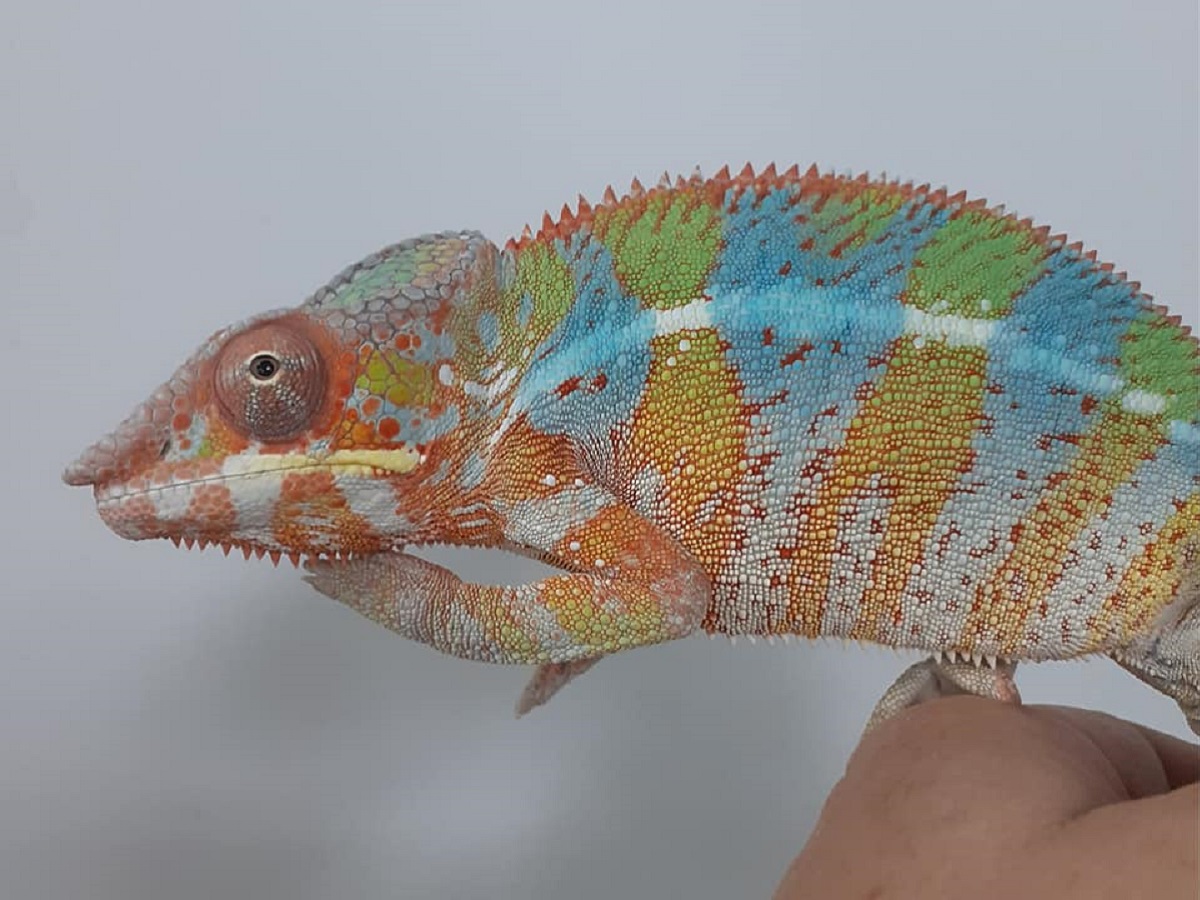Panther Chameleon
Furcifer pardalis

In the 1970’s many wild caught Panther Chameleons were exported from Madagascar. This has since become illegal, so all of the Chameleons in the pet trade are captive bred.
Latin Name: Furcifer pardalis
Difficulty Level: Expert
Temperament: Docile
Life Span: 2 – 7 Years
Size: Male 12″ – 20″ / 140g – 220g ¦ Female 8″ – 14″ / 100g
Habitat: Madagascar – Warm, Humid Jungle.
Diet:
Insects – Locusts, Crickets, Mealworms, Roaches.
Feed Waxworms as a treat.
Feed an adult around 4 times per week.
The Insects should not be larger than the Chameleon’s head, and should be gut-loaded with veggies prior to feeding.
Food to avoid: Cabbage, Figs, Apricots, Iceburg Lettuce, Spinach.
Supplements: Calcium, Vitamin A, Vitamin D.
Do not feed Vitamin D to babies.
Hours of Activity: Diurnal – Panther Chameleons are most active during the day time.
Handling: Avoid handling as this causes extreme stress to the animal. Only handle when you must e.g. when moving vivarium, or deep cleaning the vivarium.
Allow the Chameleon to grip around your fingers at its own pace.
Temperature:
25°C Ambient day time temperature.
32°C Basking temperature.
23°C Minimum night time temperature.
Humidity: 50% – 70%
Vivarium Size: 60cm x 60cm x 100cm (Minimum)
Substrate Type: Bark, Soil, or a mixture of both. Leaf litter can also be used.
Equipment Necessary: Enclosure, Heat Lamp, Thermostat, Misting System, UV Lighting.
Cleaning Instructions: Spot clean any waste and uneaten food. Completely empty and deep-clean the enclosure once per month. Change substrate weekly. Clean any plastic plants weekly.
Healthy Behaviour: Bright and Vibrant Colours, regularly climbing branches, quick reflexes when feeding, eyes moving about with ease, smooth and supple skin with no infections.
Sick Behaviour: Pallid colouration, weight loss, refusing to eat, vomiting, pale mucus membranes.
Males are hardier than females and tend to live longer. Females will turn dark brown or black when gravid.
Only keep one Male specimen in each enclosure, as they are highly territorial and will fight. A bonded pair can be housed together safely.
Provide them with plenty of branches to climb. Foliage can be either real plants or plastic. If you opt for real plants, keep an eye on the Chameleon so that it doesn’t try and eat them all.
Mist the enclosure 2 – 4 times per day. Provide slow running water, or water that drips into a shallow bowl for them to drink from.
Common Problems:
Hypovitaminosis A – This can lead to blindness and is avoided by feeding the Chameleon with Vitamin A supplements.
Metabolic Bone Disease – Obvious signs of this are if the Panther Chameleon looks lethargic and is dragging its body, instead of standing proud on its limbs.
This is avoided by feeding Calcium supplements.
Stress – Chameleons are extremely susceptible to stress. This can overwhelm them and lead to death, and is avoided with good husbandry and care.
Intestinal Impaction – A sign of this is constipation.
This is caused by the Chameleon consuming the substrate, most often sand or gravel.
